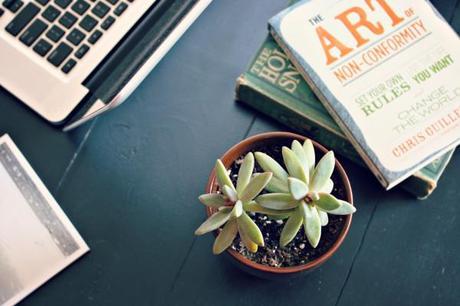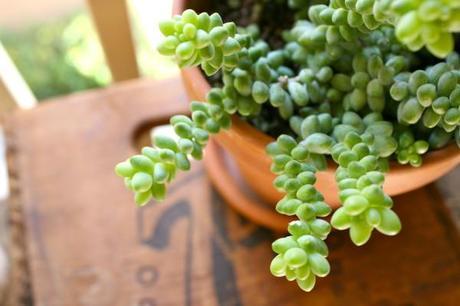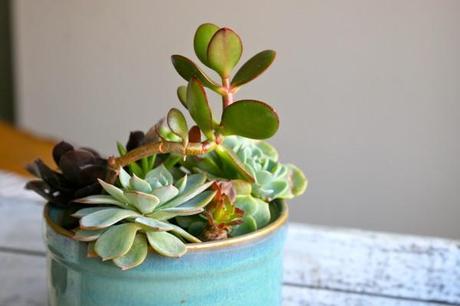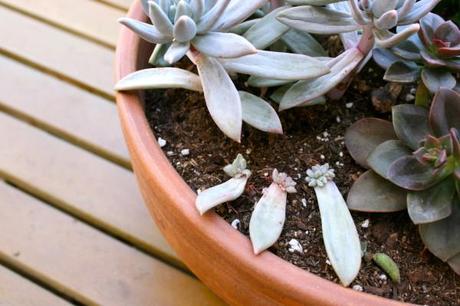
Someone once told me that succulents are easy to take care of because you basically leave them alone and they can never die. I don’t know who that someone was, but they were lying. While we all wish the saying was true, the real truth comes from careful monitoring of your plant’s health and following some pretty easy steps. After a few years of watching mine go through the flourish (this plant looks AMAZING!) to death cycle (why is it shriveled and nasty?) I’ve come up with some fundamental tips to help your succulent friends live a long and happy life.
What tools do I need to care for a succulent?
Stick to the basics here and you’ll be fine – Miracle-Gro Cactus, Palm, and Citrus potting mix works great and is nice and fluffy to the touch (less than $5 per bag at Home Depot). Most gardening pros recommend pots with drainage holes, but I’ve found mine thrive in either setting. You may also want a squirt bottle or watering can with multiple holes for dispensing (like this one from Target).

What type of light and watering schedule do they require?
This is where most people start to face frustrations with succulent care. While these water-retaining desert plants do love the sun, they should hardly ever be placed in hot, direct sunlight for long periods of time. Such drastic exposure to heat and light can cause the leaves to “burn” and produce spots, or even change the color of your entire plant (for example: from vibrant green to a dark sandy purple). Ours especially love the front porch (where we only get indirect sunlight), and even do great in the shade! As far as watering goes, pay careful attention to the leaves and soil to determine how much to water it. If you’ve replanted your succulent into another container, gently lift the entire thing out of the pot and analyze the “body” of soil – if it’s completely dry and dusty, offer your plant a good watering by pouring water in (some experts advise only spritzing succulents, however this doesn’t allow water to soak all the way to the roots). If you have plants with thick, fleshy leaves and they appear wrinkly, this is also a sign of under-watering. Give your plant a hefty drink and wait a day or two – it should plump up in no time. If it does not, do the “soil check” again and continue watering in intervals until the wrinkles in the leaves have disappeared – try not to over-water as wet soil is hard for the plant to escape and can lead to icky diseases.

White Mold
(Like I said). From time to time, especially in the winter, succulents are prone to powdery, white mold at the base of their leaves. This is actually a fungus that can be caused by damp conditions and not enough time in warm, dry weather. As this mold is contagious to other plants, set it apart from the rest of your garden and spray it with a fungicide containing Neem Oil (I use Bayer’s Natria Neem Oil, $8.97 at Home Depot). It’s a little stinky and should not be sprayed near pets or indoors, but it does the trick. Spray it every few days and allow the plant to get some good time in the sun. After a few weeks, the problem should disappear, especially if the plant is given some good time outdoors. It’s also ok to spray neighboring plants if you believe they could be / become infected. The oil is naturally-derived and will not do damage to them.
How can I tell if my succulent is growing?
Succulents tend to be pretty stunted in the winter months, but come warmer weather, growth can be observed by the shedding of dry leaves towards the base of the plant (old growth that turns crispy and can be picked off easily). Sometimes this includes the leaves on the outer edges (like that of an Echeveria). As long as the body of the plant is plump and without major blemishes or obvious dryness or stretchy leaves, you’re in good shape!

What to do with Cuttings, Broken Leaves, and Stalks
My faaaaaavorite thing about succulents is their ability to regrow. With the arrival of spring, many of our plants have sprouted new growth in between mature leaves, along the stem (where other leaves have fallen off), and up through the soil. This arrangement (above) was completely made from cuttings I found - bits from neighbors, stalks that I soaked in water to revive, and even a few from public planters that had been damaged by passerby’s and nasty weather (that’s totally cool right)? : ) If you notice any fallen leaves from your plants, keep them placed on top of the soil (like the image below) and they will eventually sprout roots and tiny leaves of their own; the beginning of a new plant. Don’t try to plant them into soil right away; they are too young and will die a horrible death in a few days (trust me, I’ve done it enough times to know). If you have full stalks that have broken off a larger plant (say from and Aeonium), place the stalk in a small jar with water and it will thrive! (Seems kind of contrary to the whole don’t-ever-water-succulents thing, but trust me, it works every time)! You can replant the stalks once they establish roots, but they can also last in a vase for quite a long time without the need for soil. Bottom line – don’t throw away healthy leaves or cuttings – with a little time, they will become new succulent babies for your home!

So what have we learned? Keep your succulents in a dry area with enough water to sustain them for a week or two. If you have a few plants indoors, switch them outside every few weeks to regulate moisture levels (soggy soil = bad, but bone-dry soil for a long time isn’t great either) and be sure to keep them out of intense heat, especially during the summer. They love dry shady areas with a consistent dose of daylight and can be planted in almost any type of container (which makes decorating a breeze)!!!
How about you? Any succulent tips you’ve learned along the way? Would love to hear!
Have a fabulous weekend!
xoxo

